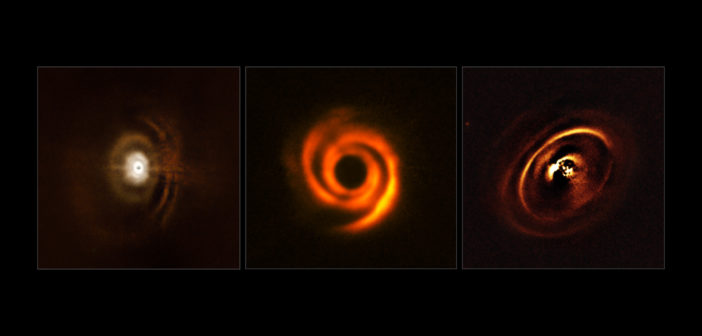Some of the most spectacular images to come out of observatories like the Atacama Large Millimeter/submillimeter Array (ALMA) or the Very Large Telescope (VLT) are detailed views of protoplanetary disks. These disks of gas and dust around young stars aren’t just smooth and featureless; instead, they exhibit arcs, rings, gaps, and spirals. What causes this impressive array of structure?
Scientists have primarily focused on two explanations:
- The structures are caused by the perturbations of massive baby planets interacting with the disk as they orbit.
- The structures are generated by various instabilities within the disk that cause the gas and dust to clump.

This ALMA image of the protoplanetary disk surrounding the star HL Tauri reveals the detailed substructure of the disk. [ALMA (ESO/NAOJ/NRAO)]
Outcome of a Crash
Collisions of large bodies — planetesimals and planetary embryos — are likely common during the formation of planetary systems around young stars. Some gentle collisions may help build up the mass of these bodies as they grow into planets. But objects that smash together at high enough velocities will be completely destroyed in the process, generating an expanding cloud of many smaller bodies and particles.
This cloud won’t remain stationary, however; instead, it will continue to orbit within the protoplanetary disk. Due to the different speeds of the various particles, the initial debris clump should be sheared out into arced structures that might persist for multiple disk orbits.
Could this process faithfully reproduce the disk structures that we’ve observed with ALMA or the VLT? Demidova and Grinin conduct simulations to find out.
Dragging Debris in a Disk
By modeling an expanding debris cloud within a disk that starts at a distance of 30 AU from its solar-mass star, the authors show how the dust and gas will evolve over several disk orbits. They then produce simulated observations of the results at a wavelength of 1.3 mm.

Simulated 1.3-mm observations of the evolution of an expanding debris cloud over 40 orbital periods of the cloud center. Time steps advance from top left to bottom right panel. Click to enlarge. [Demidova & Grinin 2019]
There are still many open questions about the structure of the disks around young stars, but this work shows that there are also many potential answers. As planetary systems form, collisions may both grow planetary embryos and destroy them, possibly causing some of the disk features that we’ve observed. One thing is for certain: the environment around young stars is certainly dramatic!
Citation
“Catastrophic Events in Protoplanetary Disks and Their Observational Manifestations,” Tatiana V. Demidova and Vladimir P. Grinin 2019 ApJL 887 L15. doi:10.3847/2041-8213/ab59e0

5 Comments
Pingback: From AAS NOVA: “Catastrophic Collisions in Protoplanetary Disks” | sciencesprings
Pingback: Colisiones catastróficas en discos protoplanetarios – Observatori Astronòmic
Pingback: Marzo 2020 – Observatori Astronòmic
Pingback: Colisiones catastróficas en discos protoplanetarios « SEDA / LIADA - RedLIADA - Cursos LIADA - Cielo del Mes - Fenómenos Astronómicos - RELEA
Pingback: Colisiones catastróficas en discos protoplanetarios | Sección de Exoplanetas - Planetas extrasolares / LIADA Liga Iberoamericana de Astronomía